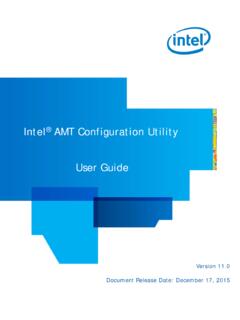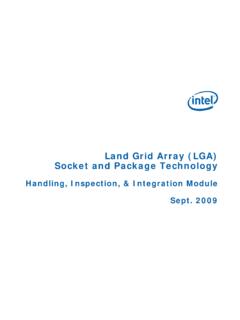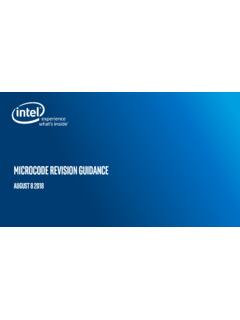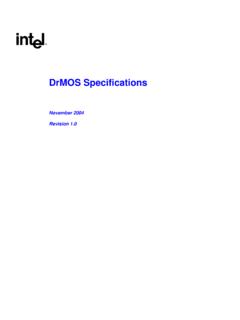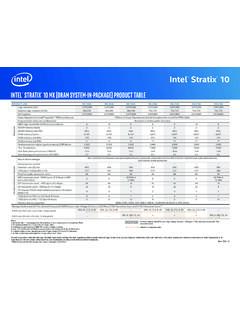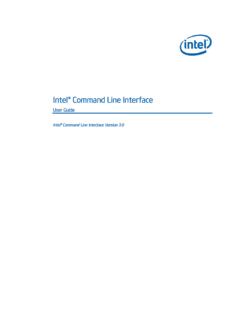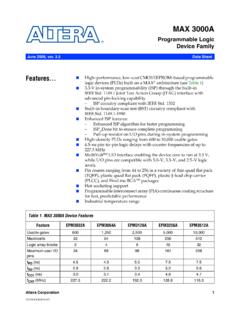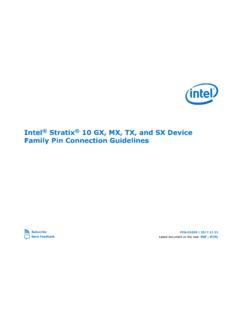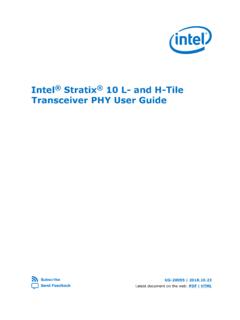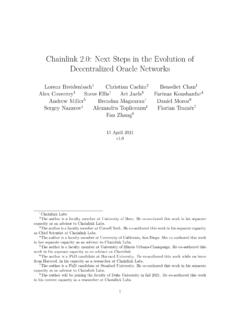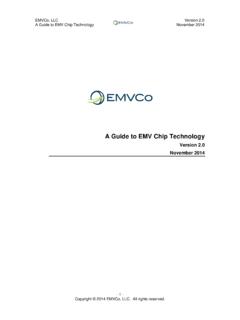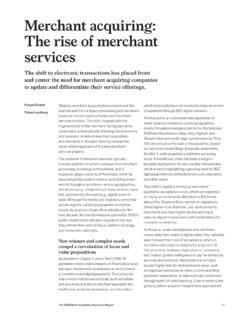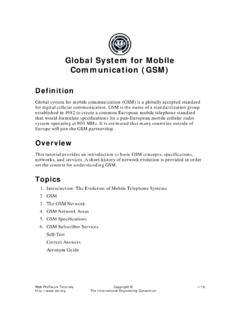Transcription of Carlos Cordeiro CTO, Wireless Communications Intel …
1 Carlos CordeiroCTO, Wireless CommunicationsIntel CorporationJuly 20202 AgendaWi-Fi GenerationsWi-Fi Market and GrowthFundamentals of Wi-Fi 7 Major Trends Impacting Wireless EvolutionBeyond Wi-Fi 7 Current Generations of Wi-Fi3Wi-Fi 5Wi-Fi 6Wi-Fi 4Wi-Fi 6E Extends Wi-Fi 6 with 6 GHz band operation* Launching Jan 2021 Based on IEEE , 5, 6 GHz band operationOFDMA, UL and DL MU-MIMO, target wake time (TWT), 1024-QAMBest-in-class WPA3 securityMax data rate: GbpsLaunched Aug/2019 Based on IEEE GHz band operationUp to 8x8 MIMO, DL MU-MIMO, 80 MHz and 160 MHz channels, 256-QAMMax data rate: ~7 GbpsLaunched June/2013 Based on IEEE and 5 GHz band operationUp to 4x4 MIMO, 40 MHz channels, 64-QAMMax data rate: ~600 MbpsLaunched in 2007* 6 GHz operation subject to regulatory rules in each economic value~2 trillion in economic value in 2018Wi-Fi Market Economic 2022, ~60% of global mobile traffic will be offloaded to Wi-Fi and51% of total IP traffic will be Wi-Fi** 45 New experiences ( , industrial IoT, 3D/XR content, real-time collab.)
2 Demand more responsive connectivity Compute shifting closer to the user, thereby redefining end-to-end (E2E) network performance , low, single-digit and sub-1ms latency become broadly available Low E2E latency across the network enables new services and experiencesNew Experiences Demand Continuous ImprovementHigh performance Wireless access essential to meet growing demandWi-Fi 6/6E: A Giant Leap ForwardImproved Protection2x2 ACWi-Fi 66 Increasingly stringent usage ( , industrial IoT, AR/VR, robotics, cloud gaming) requirements demand continued evolution4 XOFDMA enables managed, reliable, efficient connectivity across more devices.
3 This means plenty of headroom for future growth or fewer APs required to support existing SCALABILITYREDUCED INTERFERENCEOBSS enhancements help routers and devices identify local traffic and tune out noise from other SECURITYWi-Fi 6 uses new WPA3 security features, enabling next -generation authentication and best-in-class QAM and support for optional 160 MHz channels enable clients and routers to deliver best-in-class Gigabit speeds for the office or ~75%Wi-Fi 6 helps slash lag times to give you the edge you need to win with OFDMA data management and OBSS interference avoidance !DATAStd. 2x2 AC/80Wi-Fi 6 (Gig+)* next : Wi-Fi 7 Based on IEEE Amendment to , building on 11ax Maximum throughput of at least 30 Gbps Frequency range: between 1 & GHz Improvements to worst-case latency & project goals*Target timelineTargeted usagesSpec.
4 Framework Pub5 yearsMay 2019 July 2018 May 2024 May2019 Sept202014 moNov2020 May20217 yearsMay20247 CapacityPeak Data RateUser Experience Data RateSpectrum EfficiencyCost EffectiveLow LatencyConnection DensityNetwork Energy EfficiencyKey Enhancements320 MHz channels4096-QAM16 spatial streamsMulti-link operationMulti-AP operationDeterministic low latencyMulti-RU (puncturing)* Accurate as of June/2020. Feature set and their specification are subject to Wi-Fi 7 Features* Universal SIG (U-SIG) defined for forwardcompatibility ( , version, UL/DL, TXOP duration) EHT-SIG with common and user-specific partsPHY Enhancements: BasicsExemplary 40 MHz packet:9 Preamble and packet format Max single channel bandwidth increased from 160 MHz (Wi-Fi 6/6E) to 320 MHz Tone plan for 320 MHz use duplicated 160 MHz tone plan based on Wi-Fi 6 Channelization and 320 MHz channels* Number of 320 MHz channels dependent upon regulatory rules per country.
5 *10 PHY Enhancements: Multi-RU (Puncturing) Multi-RU is created by puncturing the operating channel Puncturing granularity = 20 MHz Main motivation is to avoid transmitting on frequencies that are locally unauthorized by regulation due to incumbent operation11 PHY Enhancements: Data RateParameterWi-Fi 6Wi-Fi 7 Max channel bandwidth160 MHz320 MHz (3 channels in 6 GHz)Highest modulation order1024-QAM4096-QAMMax number of spatial streams816 Max data rate*~ Gbps~ GbpsWi-Fi 7 onlyWi-Fi 6 & 7 * This reflects the maximum theoretical data rate. Practical data rates depend on many factors, including on the capabilitiesofan AP and its associated data rate increase of about compared to Wi-Fi 60100020003000400050006000256 (1)256 (2)1024 (1)1024 (2)4096 (1)4096 (2)Data rate (Mbps)QAM order (Number of spatial streams)Wi-Fi 7 vs.
6 Wi-Fi 6 data rate comparison80 MHz160 MHz320 MHzMulti-link Operation (MLO)AP1AP2AP3 Multi-link device A (AP)STA1 STA2 Multi-link device (STA)DataDataLink 1 (Channel X, Band Y) Link 2 (Channel L, Band M) MLO enables link aggregation at the MAC layer A link is mapped to a channel and bandMLO brings benefits in multiple dimensions: Additive throughput for data flows split over links For two links ( , 5 GHz and 6 GHz), max aggregate data rate could reach compared to Wi-Fi 6 Lower latency due to access to multiple links in parallel High reliability by packets duplication over multiple links Assign data flows to specific links based on app needs12 MLO provides higher throughput, lower latency and/or higher reliability, which are useful to a number of applications from VR/AR to industrial IoTSTA3 Multi-link Operation: Types of MLOD ifferent MLO implementation options are possibleMLO typeNo.
7 Of full function 11be radiosCharacteristicsMulti-link single radio (MLSR)1 Able to RX and TX over one radio at a timeEnhanced MLSR (eMLSR)Enhances MLSR with a reduced function radio to choose best linkNon-simultaneous TX and RX multi-link multi radio (Non-STR MLMR) 2 Able to simultaneously RX and TX over 2 radios, but only under certain constraints ( , freq. separation, aligned TX/RX)STR MLMRAble to simultaneously RX and TX over 2 radiosComplexity & load (%)010020030040050060080 MHz, 2x2, MCS4, RTS onmulti-link single radiosingle-link single radiomulti-link multi radio (concurrent)Tput (Mbps)eMLSRMLSRSTR MLMR (2 radios)14 Multi-AP FeaturesMulti-AP refers to a collection of features that rely on direct AP coordination to achieve desired network performance goalsDifferent flavors of multi-AP solutions are being consideredMulti-AP schemesMAC drivenCoordinated OFDMAC oordinated spatial reuse (SR)Coordinated TDMAPHY drivenCoordinated beamforming (BF)Coordinated joint processing (JP)
8 SharingAPShared AP1 Shared AP215 Multi-AP Features: MAC DrivenShared AP2 Shared AP1RU1RU240 MHz channelTimeFreqRU40 MHz channelTimeFreqTbTcShared AP1 Shared AP2RU40 MHz channelTimeFreqTaShared AP1 Shared AP2 ExampleExampleExampleCoordinated OFDMA, Spatial Reuse (SR) & TDMAA sharing AP triggers shared AP(s) so that shared AP(s) can perform one of:Coordinated OFDMAAP(s) transmit simultaneously to their associated STAs on different OFDMA resource unitsCoordinated SRAP(s) transmit simultaneously to their associated STAs on the same resource unitsCoordinated TDMAAP(s) take turn in transmitting to their associated STAs on the same resource unitsMulti-AP Features.
9 PHY DrivenSharing APShared APSharing APShared AP16 Coordinated BF or JPCoordinated BFA sharing AP can sound channels from their own STAs and from STAs associated with a shared APSharing AP can then transmit simultaneously to its own STAs on the same resources as shared AP is transmitting to its own STAs, while nulling the interference towards the shared AP s STAsCoordinated JPFor STAs that are able to receive from multiple APs, JP enables the use of the sum of antennas from all the transmitting APsComplexity & performance17 Deterministic Low Latency Enhancements Wi-Fi 6 can achieve single-digit millisecond latency, but the worst-case latency can be high in congested environments With the introduction of features like multi-link operation, multi-AP and 320 MHz channels in Wi-Fi 7, latency will be reduced even further However, to provide deterministic low latency required by some usages ( , industrial IoT, AR/VR), new schemes need to be definedLLLLVOVOVIVIBEBETime-Aware FunctionSME-MLME SAPP ause/Resume Wi-Fi 7 features for deterministic low latency Define QoS provisioning model with dedicated, deterministic, low-latency (LL)
10 And reliable access category Scheduled channel access with TSN functionality Packet preemption for predictable channel access Limit TXOP duration across networks18 Problem StatementWi-Fi hotspots can be found virtually everywhere, but clients connecting to these hotspots are either disallowed ( , lack of credentials) or cumbersome ( , captive portal)SolutionOpenRoaming (OR) is an industry initiative that aims at connecting clients to Wi-Fi networks as seamless and pervasive as in cellular Based on Passpoint technology Scalable, many-to-many business relationshipsOpenRoaming: Anywhere & Any Network Connected Wi-Fi ClientsIdentity ProvidersEnd-Users/Devices Phones, PCs, IoT, etc.
